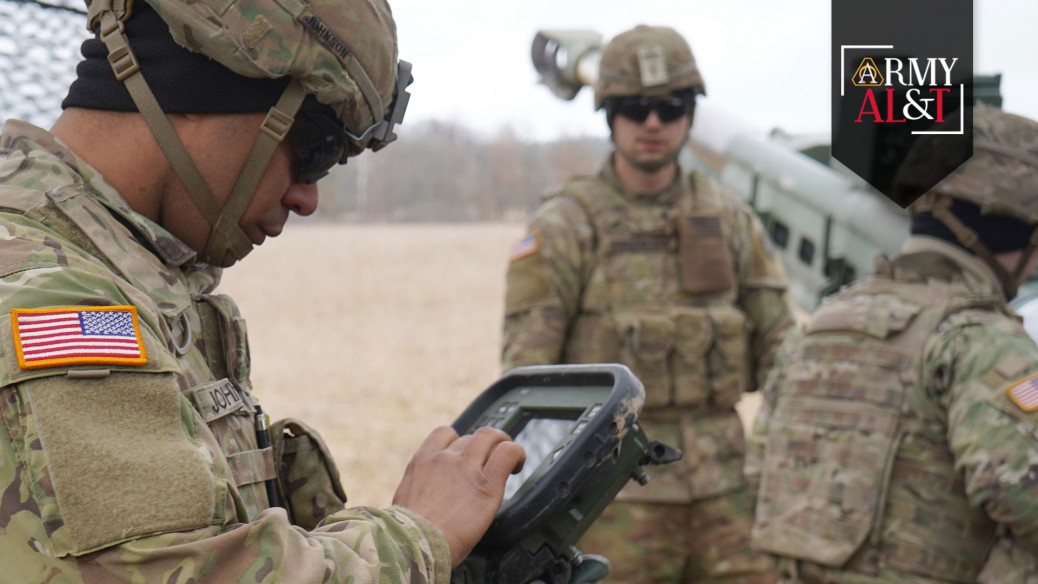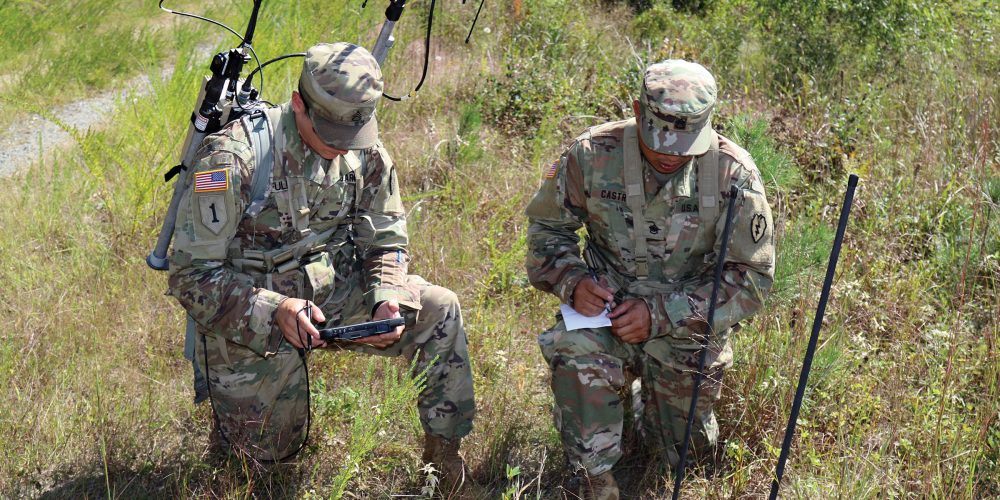The Army Leader Dashboard is tackling the Army’s data problem, bridging the gap between assumptions and insights for strategic resource decisions.
by Ellen Summey
The Army has a data problem. To make informed decisions about resource allocation and readiness, senior leaders need access to reliable, trusted and timely data. While the Army has mountains of relevant data, it is not always readily accessible, verified or authoritative. Compounding the matter even further, data is frequently duplicated or of questionable quality.
To put the problem in perspective, Dr. Bruce D. Jette, Army acquisition executive, shared a tongue-in-cheek anecdote during a town hall meeting in November at Fort Belvoir, Virginia, about how he might determine the exact number of tanks the Army has.
“I call J.B., my XO [executive officer],” Jette said. “I ask him, ‘J.B., how many tanks do we have?’ He says, ‘Sir, I’ll find out and get right back to you.’ Right back to me is a week.” Jette illustrated the chain of events that might follow. His executive officer would ask someone, who would call someone else, before the task eventually fell to the person who would walk out into the rain to manually count tanks in a parking lot.
The anecdote illustrates a complex problem that leaders face every day: Army data is housed in hundreds, if not thousands, of disparate systems that typically don’t communicate with one another. Sometimes the single, authoritative source for one type of data is a spreadsheet on a supply sergeant’s desk. So how might senior leaders access that information when it is needed?
That was the question put to the Program Executive Office for Enterprise Information Systems (PEO EIS) by Gen. Mark A. Milley, Army chief of staff. Milley wanted a way to access and visualize those troves of Army data, to inform decision-making at the executive level. The challenge, then, was to identify the sources of relevant data, connect to them and provide the sort of display Milley was seeking. After researching commercially available solutions and related systems used by other services, Milley and PEO EIS set out to obtain a secure, web-based application that could be accessed from any approved device.

AND SO IT GROWS
The initial idea for the dashboard was a secure app that Army leaders could check from any approved device to access data across different functions. Because of its potential utility, the concept grew into the Army Leader Dashboard initiative.(Graphic by U.S. Army Acquisition Support Center (USAASC); SOURCE: PEO EIS)
TACKLING THE COMPLEXITY
This ambitious project, called Army Leader Dashboard, quickly morphed into more than just a simple display for Army data. As PEO EIS assembled a team and coordinated vendors and contracts, Milley provided feedback to shape early prototype development. Through this process, he and other senior leaders began to understand two important things: First, the data problem is even more complex than they initially assumed. Second, the dashboard tool could provide a tremendous amount of insight if applied more broadly across Army domains.
“It was born as a readiness platform,” said Col. Kyle Jette (no relation to Dr. Bruce Jette), an Army G-8 (Programs) data analyst and the dashboard’s data expert. “It had a smaller scope than it does now but, as Gen. Milley saw the prototypes, he was so impressed by the power and the potential, and he wanted all Army data brought in.”
With that directive, the team had a steep hill to climb. Early efforts identified more than 700 unique sources of data, all of which might potentially need to be linked to the dashboard. Those data sources run the gamut from training databases to equipment inventories, personnel records and maintenance reports.
“There is a data capture team that interacts with the data sources, and they work to identify applicable data,” said Rajat Senjalia, technical director for the Strategic Initiatives Group at PEO EIS, which leads the dashboard project. “They utilize different technologies to bring that data in, whether that data is structured, unstructured, semi-structured, what type of data source it’s coming from and what type of connection is required to absorb that information.”

THE MISSION AND VISION
The project team identified more than 700 sources of data as it began work on the data dashboard. (Graphic by USAASC; SOURCE: PEO EIS)
Finding that data is just the first step. The dashboard team then makes contact with the data’s owners to identify which pieces are relevant and needed for senior leaders. At first, the team set out to capture any and all data from those identified sources. Over time, it developed a more targeted approach, seeking only data that is original and authoritative from each source.
“What we’re looking to do is methodically and deliberately go through one domain at a time,” said Col. Jette. (A domain might be “people,” “training,” or “equipment.”) “We’re having the leaders from each domain identify the priority systems that are their ‘center of mass.’ There are, in some cases, scores of data systems within a particular domain, and we simply don’t have time to cover all of them, so we’re asking the domains to identify the top 10 or so. We discuss those, how they relate to each other, how they provide original information to the Army.”
That original information is key. For example, the Army Leader Dashboard will need to pull data from the Logistics Modernization Program (LMP), also at PEO EIS. LMP alone has some 40 terabytes of data—more than 17 billion single-spaced, typed pages. However, of those 40 terabytes, only a fraction is original and authoritative information, so the challenge is to identify which pieces to pull and which to disregard.
WHICH DATA IS THE BEST?
The team focused on the concept of “cornerstone data”—that is, the Army’s uniquely identifiable things. “We’ve identified the need for at least four categories: people, units, major equipment and places, at the site level,” Col. Jette said. “I’m an individual; I can always be identified by my Social Security number. A unit will have a unit identification code, a piece of major equipment will have a 16-digit item unique identifier [UID], and places will have a site UID or a particular building will have a real property UID.”
The dashboard team then builds on that cornerstone data, linking the many thousands of secondary attributes associated with those uniquely identifiable things. If a commander wanted to locate all active-duty sergeants stationed at Fort Bliss, Texas, who have Chinese language proficiency and advanced cybersecurity certifications, the dashboard would enable that search.
Part of the challenge, though, is deciding which is the primary, trusted source for a given dataset. For instance, human resources data is sprinkled across nearly every system the Army operates. A Soldier’s name, date of birth, Social Security number or other relevant details are repeated over and over again across domains and systems. Whether the Soldier manually re-enters that information (for a medical appointment, perhaps), or it is copied directly from another source, it is duplicated many times over, but only one source for it should be linked to the dashboard.
“When I come into the Army, my basic information should go in once and only need re-entry upon change,” said Chérie A. Smith, program executive officer for EIS. “Some things may change. I might get married, I might have a couple of kids, but my basic information will remain the same. However, because we have all these systems that have grown up on their own, we’re re-entering that information a million times. And why do we do that? The reason is, when you’re looking at it from one system view, it’s always cheaper to do the manual re-entry than to build the interface [to an existing system].”
In truth, no one would have designed the Army’s data systems to look the way they do today. It’s not by design, but by a lack of design, that Army data exists in silos and can be difficult to access. Imagine how a city might look if it grew with no urban planning, zoning or infrastructure oversight. Anyone who needed a house or an office would be free to build one, but there might be no power grid and no city water supply. It would be a bit like the Wild West. That’s essentially how the Army’s data systems developed.
“You look at these planned communities where everything is pretty and operational, but they knew what the result was before they started,” said Lt. Col. Rob Wolfe, Strategic Initiatives Group director and the lead for the dashboard project. The Army “didn’t do that. We have 50-year-old systems in one place, and we have 1-year-old systems in another place.”

ONE OF MANY DATA SOURCES
Pvt. Sherry Chapman, a logistician with Theater Movement Control-In-Transit Visibility, 21st Theater Sustainment Command (TSC), enters equipment information into the Single Mobility System on the Portable Deployment Kit tablet. (Photo by Staff Sgt. Adrian Patoka, 21st TSC)
GETTING HERE
The Army Leader Dashboard initiative is still quite young, having been established in July 2017. PEO EIS released the solicitation on May 10, 2018, and awarded five contracts for prototypes in mid-August. Those five initial prototypes were narrowed to two by the end of 2018, with the final vendor selection expected by August 2019.
“The two prototypes we currently have are actually on Gen. Milley’s desktop and Dr. Jette’s desktop, and have been for a number of weeks,” Col. Jette said. Milley and Dr. Jette provide specific feedback about how the prototypes are performing and how well they demonstrate the correlations between data.
That feedback and rapid prototyping were made possible by an other transaction authority agreement, which provides a shortcut compared with the traditional acquisition process for certain programs. Such contracts can be especially important for technology and software projects, in which solutions quickly become outdated or obsolete.
“The use of [other transaction authority] has been huge for us,” Smith said. “It has enabled us to do things that wouldn’t have been possible before, in terms of rapidly prototyping and producing new products. [It] isn’t right for every kind of project, but it’s great for software.”
CONCLUSION
The dashboard team remains focused on compiling, testing and understanding the Army’s data, but Wolfe is also looking at the road ahead. He believes the Army Leader Dashboard solution could eventually serve as a “common data platform” for the entire Army. “There are hundreds of dashboards in the Army,” Wolfe said. “Every command is pulling from similar datasets, but data has a ‘date/time’ stamp for truth. If we get to the point where we’ve successfully gotten all this data together and curated it so it’s trustable and reliable and timely, then anybody else who has a dashboard can leverage [the Army Leader Dashboard] as their source of data. Then our leaders can talk apples to apples. We have to have one version of the truth for data.”
The Army Leader Dashboard was designed to address data problems within the Army’s business systems and enterprise mission areas—logistics, human resources, finance, and so on—but similar issues plague the weapons and intelligence systems as well. Wolfe believes the dashboard process could be applied there with comparable results.
“I think some of the processes and models we’ve built to get after data quality could be applied to the other mission areas,” he said. “There are a lot of lessons learned that could be applied to keep the other mission areas from making the same mistakes, to expedite their path toward data quality. In my years in the Army, I don’t know that I’ve ever come across a problem that somebody hasn’t faced before. We try to leverage what other folks are doing: Take the best of what everybody’s doing, to make a comprehensive, executable approach.”
Ultimately, Smith believes the Army Leader Dashboard is changing the way the Army approaches its data. If data is inaccessible, unusable or unreliable, it is essentially useless. “We have been focused for 20 or 30 years on transactions, and I think we’re going to start really, truly making that leap to focusing on the data and the information.”
For more information on the Strategic Initiatives Group or the Army Leader Dashboard initiative, contact the PEO EIS Strategic Communication Directorate at usarmy.peoeis@mail.mil.
ELLEN SUMMEY provides contract support to PEO EIS at Fort Belvoir for Bixal Solutions Inc. She holds an M.A. in human relations from the University of Oklahoma and a B.A. in mass communication from Louisiana State University. She has more than a decade of communication experience in both the government and commercial sectors.
MORE THAN THE USUAL DASHBOARD
According to the Army Data Strategy, data should be visible, accessible, understandable, trusted and interoperable. Lt. Col. Rob Wolfe, Strategic Initiatives Group director at PEO EIS and the lead for the dashboard project, said the dashboard team has been driving the kinds of conversations that will help achieve that goal.
“What we’re seeing is a change in the way the Army governs and manages data,” Wolfe explained. “These problems are driving change—hopefully, enduring change—so that we can maintain consistent, quality data. Between the Office of Business Transformation, which is responsible for architecture, the Army Analytics Board, which is responsible for how we integrate and analyze data, and the Army Data Council, which is responsible for standards, we are seeing those bodies getting into the same room and having conversations that the Army hasn’t had before.
“It’s more than just a dashboard,” Wolfe continued.
“It’s the first thing we’ve seen that allows leaders at all echelons of command to look across domains. There are a lot of systems that allow you to look at people, to look at equipment, to look at training, but there are not any systems that allow you to look across all those areas and see how resourcing decisions in training affect people, or vice versa. We’re really trying to give leaders a tool to make strategic resource decisions and understand the impacts across the Army.” His goal is to enable “insight-driven” decisions.
For the dashboard team, readiness is the bottom line. “What previously could take multiple weeks is now being done in real time,” said Rajat Senjalia, technical director for the Strategic Initiatives Group. “When senior leaders can utilize one tool that can aggregate the necessary information, it enables you to make an executive-level decision on anything from troop movement to resource allocation. That is invaluable to the Army.” – Hence Greased Lightning 2019!

















